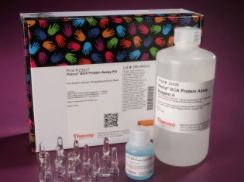 首页>
生物试剂
首页>
生物试剂
商家描述
产品评价(0)
The Pierce BCA Protein Assay Kit is a high-precision, detergent-compatible protein assay for determination of protein concentration. Pierce BCA reagents provide accurate determination of protein concentration with most sample types encountered in protein research. The Pierce BCA assay can be used to assess yields in whole cell lysates, affinity-column fractions, purified proteins samples, as well as to monitor protein contamination in industrial applications. Compared to most dye-binding methods, the BCA assay is affected much less by protein compositional differences, providing greater concentration accuracy.
Kit options are available that include Pierce Dilution-Free BSA Protein Standards, which are a set of seven pre-diluted BSA standards, packaged in a multichannel pipette-friendly tubestrip. The tubestrip includes a single empty tube that enables users to add their own sample buffer for the purpose of blank subtraction.
Features of the BCA Protein Assay Kit include:
• Colorimetric—estimate visually or measure with a standard spectrophotometer or plate reader at 562 nm
• Accurate—exhibits half the protein-to-protein variation observed with dye-binding methods (Bradford)
• Compatible—unaffected by typical concentrations of most ionic and non-ionic detergents
• Short assay time—30-min incubation; much easier and four times faster than classical Lowry methods
• Wide assay range—linear working range for BSA of 20 to 2000 µg/mL
• Sensitive—detect down to 5 µg/mL with enhanced protocol
• No more serial dilutions—kit options include Dilution-Free BSA Protein Standards which eliminate the need to perform serial dilutions when generating a standard curve
How the assay works
The BCA Protein Assay combines the well-known reduction of Cu2+ to Cu1+ by protein in an alkaline medium with the highly sensitive and selective colorimetric detection of the cuprous cation (Cu1+) by bicinchoninic acid (BCA). The first step is the chelation of copper with protein in an alkaline environment to form a light blue complex. In this reaction, known as the biuret reaction, peptides containing three or more amino acid residues form a colored chelate complex with cupric ions in an alkaline environment containing sodium potassium tartrate.
Kit options are available that include Pierce Dilution-Free BSA Protein Standards, which are a set of seven pre-diluted BSA standards, packaged in a multichannel pipette-friendly tubestrip. The tubestrip includes a single empty tube that enables users to add their own sample buffer for the purpose of blank subtraction.
Features of the BCA Protein Assay Kit include:
• Colorimetric—estimate visually or measure with a standard spectrophotometer or plate reader at 562 nm
• Accurate—exhibits half the protein-to-protein variation observed with dye-binding methods (Bradford)
• Compatible—unaffected by typical concentrations of most ionic and non-ionic detergents
• Short assay time—30-min incubation; much easier and four times faster than classical Lowry methods
• Wide assay range—linear working range for BSA of 20 to 2000 µg/mL
• Sensitive—detect down to 5 µg/mL with enhanced protocol
• No more serial dilutions—kit options include Dilution-Free BSA Protein Standards which eliminate the need to perform serial dilutions when generating a standard curve
How the assay works
The BCA Protein Assay combines the well-known reduction of Cu2+ to Cu1+ by protein in an alkaline medium with the highly sensitive and selective colorimetric detection of the cuprous cation (Cu1+) by bicinchoninic acid (BCA). The first step is the chelation of copper with protein in an alkaline environment to form a light blue complex. In this reaction, known as the biuret reaction, peptides containing three or more amino acid residues form a colored chelate complex with cupric ions in an alkaline environment containing sodium potassium tartrate.
 会员登录
会员登录.getTime()%>)
 购物车()
购物车()

 成功收藏产品
成功收藏产品